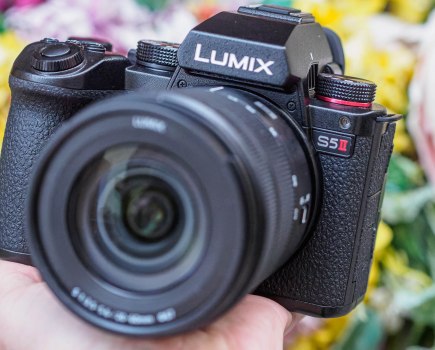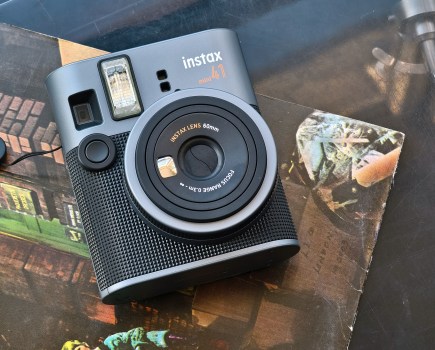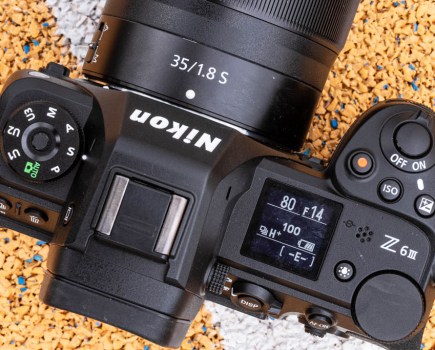 Canon EOS 5D
Canon EOS 5D
- Approx second hand price: £700-£850
- Original RRP: £2,539.99
- 2.8-million-pixel CMOS sensor
- ISO: 50-3200
- 3fps
When we first reviewed the Canon EOS 5D in November 2005, it achieved an exceptional score of 91%.
Its 12.8-million-pixel, full-frame sensor was particularly impressive at the time, and the low level of noise and good detail resolution quickly made the EOS 5D the full-frame camera of choice for many amateur photographers looking to upgrade from the EOS 20D.
It also found itself in the kit bag of professional photographers who saw the original EOS 5D as an ideal smaller and lighter second body for the Canon EOS-1Ds Mark II. So highly regarded is the EOS 5D that the body, AF and metering systems remain largely unchanged in the EOS 5D Mark II, which replaced the original model in 2008.
Despite lacking the huge number of AF points of the Nikon D3 and D700 cameras, we found that the autofocus performs well, particularly when the central point is used. However, on one occasion the AWB proved to be a little too clinical, removing the warm glow of late-afternoon sun from an interior scene. This is something we would usually associate with the Nikon white balance system.
Like Nikon D3 owners who upgraded to the D3S, many professional EOS 5D users have upgraded to the EOS 5D Mark II because of the appeal of Full HD video. This means that EOS 5D cameras can be readily found second-hand for a very reasonable price of £700-£850. It is therefore a fantastic bargain for those who don’t require HD video or the 21.1-million-pixel resolution of its successor.
 Kodak DSC Pro 14n
Kodak DSC Pro 14n
- Approx second hand price: £200-£350
- Original RRP: £4,224
- 13.7-million-pixel CMOS sensor
- ISO: 80-400
- 1.7fps
- Nikon F mount
Announced in September 2002, the Kodak DSC Pro 14n is the oldest camera on this list and was also only the second DSLR to house a full-frame sensor (the first being the Contax N Digital).
Its top half, and many of its buttons, are borrowed from the Nikon F80, but the lower part of the body is built by Kodak and houses a 13.7-million-pixel sensor.
At its launch, the Pro 14n was groundbreaking. It bettered any DSLR in terms of detail resolution, which was partly due to its lack of an anti-aliasing filter. However, it suffers from having a limited sensitivity range and noise is a serious issue.
Noise and sharpening can be improved by editing the raw images from the camera in the latest raw-conversion software rather than using the software that originally came bundled with the camera.
With no anti-aliasing filter the Pro 14n can resolve a lot of detail, but to avoid noise affecting the images the sensitivity must be kept at ISO 160 or below.
If you shoot landscape images and are happy to use a tripod, the Pro 14n is still an attractive camera that offers a great step into full-frame photography at a very good price, particularly if you already have Nikon lenses.
One thing to watch out for if buying the Pro 14n is that the battery will almost certainly need replacing. These can be found online for around £15.
 Nikon D3
Nikon D3
- Approx second hand price: £1,900-£2,200
- Original RRP: £3,399
- 12.1-million-pixel CMOS sensor
- ISO: 100-25,600
- 9fp
The Nikon D3 has now been replaced by the D3S, but it is still more than a match for most DSLR cameras available. Released in August 2007 alongside the D300, the superb image quality, particularly at high sensitivity settings, persuaded many professional photographers to switch from Canon to Nikon.
With the D3S replacing the original D3 in October 2009, many photographers once again upgraded, meaning there are a few used Nikon D3 cameras available. However, they are held in great esteem and as such still command a fairly high price.
Much of the technology that was originally found in the D3 has now filtered down and is
used in some form or another across the range of current Nikon DSLR cameras.
The 51-point AF system and 1,005-zone metering system help to produce sharp, well-exposed images. As these systems are combined with an impressive 9fps shooting rate, the D3 is a great camera for action photography and photojournalism.
Its 12-million-pixel resolution may seem low, especially given that the older Kodak DSC Pro 14n has 1.6 million more pixels, but unless you regularly take landscapes with the intention of making huge prints, the resolution should not be prohibitive.
There are a couple of things to look out for. As many D3S will have been used extensively by professional photographers, check for wear or damage, which may be a sign it has been well used.
Also, remember than the D3 doesn’t have in-camera, sensor-shift dust removal, which means that dust can often be a problem, particularly if you change lenses regularly.
 Canon EOS-1Ds Mark II
Canon EOS-1Ds Mark II
- Approx second hand price: £1,000-£1,500
- Original RRP: £6,000
- 16.7 million pixels
- ISO: 50-3200
- 4fps
Originally reviewed in January 2005, the Canon EOS-1Ds Mark II scored a superb 95% (under our previous scoring system), making it one of the best DSLR cameras we have tested.
Professional photographers agreed with AP’s verdict and, until the Nikon D3 came along, the Canon EOS-1Ds Mark II was the full-frame camera of choice for most professional studio and event photographers.
The EOS-1Ds Mark II has a respectable 16.7-million-pixel CMOS sensor, which offers a higher resolution than the D3, D3S and D700. With 45 selectable AF points, seven of which are cross points, the EOS-1Ds Mark II has an advanced AF system that is very flexible. Depending on the type of photography you are doing, the number of AF points used can be set to seven, nine, 11 or 13 points with a singleuser-selected AF point.
Even though the 21-segment metering of the EOS-1Ds Mark II doesn’t match the D3’s 1,005-point system in specification, it is extremely effective. In fact, when shooting in a variety of different situations, including under bright overcast skies, the EOS-1Ds Mark II is rarely more than 0.5EV from the optimal exposure, and spot and centreweighted metering are on hand for those more awkward situations.
As you’d expect, image quality is excellent, with colours reproduced well, and there is the option to use the originally supplied Canon software to create custom tone curves and save them to the camera for application to JPEG files.
With it being possible to find a well-used EOS-1Ds Mark II for around £1,000, the camera is an extremely attractive proposition for existing Canon DSLR users. As most EOS-1Ds Mark II cameras will have been used by professional photographers, it is best to buy one from a photographic retailer rather than a private buyer. Most stores check the condition of cameras before they purchase them and offer some sort of warranty on used equipment.








